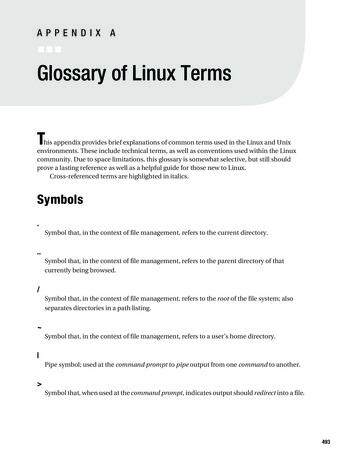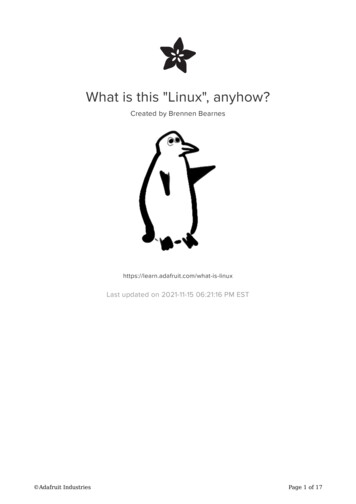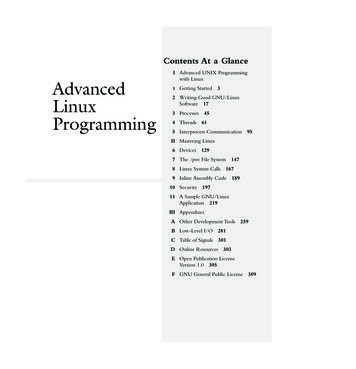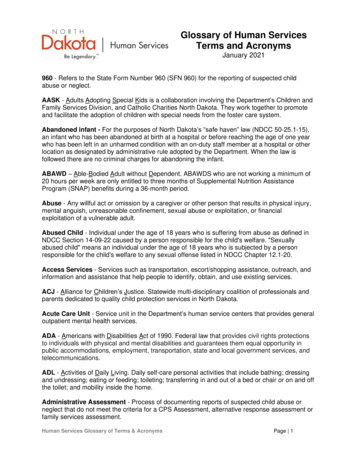
Transcription
APPENDIX A Glossary of Linux TermsThis appendix provides brief explanations of common terms used in the Linux and Unixenvironments. These include technical terms, as well as conventions used within the Linuxcommunity. Due to space limitations, this glossary is somewhat selective, but still shouldprove a lasting reference as well as a helpful guide for those new to Linux.Cross-referenced terms are highlighted in italics.Symbols.Symbol that, in the context of file management, refers to the current directory.Symbol that, in the context of file management, refers to the parent directory of thatcurrently being browsed./Symbol that, in the context of file management, refers to the root of the file system; alsoseparates directories in a path listing. Symbol that, in the context of file management, refers to a user’s home directory. Pipe symbol; used at the command prompt to pipe output from one command to another. Symbol that, when used at the command prompt, indicates output should redirect into a file.493
494APPENDIX A GLOSSARY OF LINUX TERMS Symbol that, when used at the command prompt, indicates a command should accept inputfrom a file (see redirect).#Symbol that, when it appears on the command prompt, usually indicates the user is currentlylogged in as root. Symbol that, when it appears on the command prompt, usually indicates the user is currentlylogged in as an ordinary user. (Note that some versions of Linux/Unix use % or instead of .)?Wildcard character indicating that any character can be substituted in its place.*Wildcard character indicating that zero or more characters can appear in its place.*nixPopular but unofficial way of describing the family tree that comprises Unix and its variousclones, such as Linux and Minix.AadministratorAnother word for either the root user or one who has adopted that user’s powers temporarily.AIXIBM’s proprietary form of Unix that runs on the company’s proprietary hardware, as wellas commodity hardware based around AMD and Intel processors. Nowadays, IBM is slowlydeprecating AIX in favor of Linux.aliasMethod of creating a user-defined command that, when typed, causes another command tobe run or a string to be expanded.ApachePopular Open Source web server software that runs on Unix, Linux, and other operatingsystem platforms. Considered responsible in part for the rise in popularity of Linux in thelate 1990s.
APPENDIX A GLOSSARY OF LINUX TERMSappletSmall program that, in the context of the Ubuntu desktop, runs as part of a larger programand offers functions that complement the main program. The GNOME desktop incorporatesseveral applets in its notification area.APTAdvanced Packaging Tool; the underlying system by which software is managed and installedon Ubuntu and Debian Linux systems. Shell commands beginning with apt, such as apt-get, areused to install new software from various repositories. Under Ubuntu, the Synaptic PackageManager program provides a GUI method of using APT.archiveAny file containing a collection of smaller files, compressed or otherwise (see also tar).BBASHBourne Again SHell. The most common shell interpreter used under Linux and offered asdefault on many Linux systems.binary executableAnother way of referring to a program that has been compiled so that it can be used day-to-day.See also compile.block deviceHow the Linux kernel communicates with a device that sends and receives blocks of data;usually a hard disk or removable storage device. See also character device.BSD UnixBerkeley Software Distribution Unix; form of Unix partially based on the original Unixsource code but also incorporating recent developments. BSD is open source and free for allto use and share with practically no restrictions. There are various forms of BSD Unix, suchas FreeBSD, NetBSD, and OpenBSD. BSD doesn’t use the Linux kernel, but it runs many ofthe same programs. Some of the programs offered within the Linux operating system comefrom BSD.bzip2Form of file compression. Together with the older and less efficient gzip, it is a popular formof file compression under Linux and the equivalent to Zip compression under Windows.Files employing bzip compression are usually given a .bz2 file extension. See also tar.495
496APPENDIX A GLOSSARY OF LINUX TERMSCCProgramming language in which much of the Linux kernel is written, as were later versionsof Unix before it. C was created by some of the same people who created Unix, and its development mirrors that of Unix.C Object-oriented programming language; originally designed to be an enhancement to C,but now seen as a popular alternative.C#Modern programming language, which uses similar syntax to C, created by Microsoft andre-created on Linux via the Mono project.character deviceHow Linux refers to a device that sends/receives data asynchronously. For various technicalreasons, this typically refers to the terminal display. See also block device.checksumMathematical process that can be applied to a file or other data to create a unique numberrelative to the contents of that file. If the file is modified, the checksum will change, usuallyindicating that the file in question has failed to download correctly or has been modified insome way. The most common type of checksum program used under Linux is md5sum.clientShorthand referring to a computer that connects to a server.closed sourceThe reverse of Open Source in which the source code is not available for others to see, share,or modify. See also proprietary.codeSee source code.commandInput typed at the shell that performs a specific task, usually related to administration of thesystem and/or the manipulation of files.command-line promptSee shell.
APPENDIX A GLOSSARY OF LINUX TERMScommodityIn the context of hardware, describes PC hardware usually based around Intel or AMDprocessors that can be bought off the shelf and used to create sophisticated computer systems(as opposed to buying specially designed hardware). One reason for Linux’s success is itsability to use commodity hardware.communityThe general term for the millions of Linux users worldwide, regardless of what they useLinux for or their individual backgrounds. By using Linux, you automatically become partof the community.compileThe practice of creating a binary file from source code, usually achieved using the ./configure,make, make install series of commands and scripts.config fileConfiguration file; any file that contains the list of settings for a program. Sometimes it’snecessary to edit config files by hand using programs like vi or Emacs, but often the programitself will write its config file according to the settings you choose.copyleftThe legal principle of protecting the right to share a creative work, such as a computerprogram, using a legally binding license. Copyleft also ensures future iterations of the workare covered in the same way.crackerSomeone who breaks into computer systems to steal data or cause damage. The term is notnecessarily linked to Linux or Unix but was created by the community to combat the widespread use of hacker in this sense. The word hacker has traditionally defined someone whomerely administers, programs, and generally enjoys computers.cronBackground service that schedules tasks to occur at certain times. It relies on the crontab file.CUPSCommon Unix Printing System; set of programs that work in the background to handleprinting under Unix and Linux.cursesLibrary that lets software present a semigraphical interface at the shell, complete with menusystems and simple mouse control (if configured). The version of curses used under Linuxand Unix is called ncurses.497
498APPENDIX A GLOSSARY OF LINUX TERMSCVSConcurrent Versioning System; application that allows the latest version of software packages tobe distributed over the Internet to developers and other interested parties.DdaemonSee service.DebianVoluntary organization that produces distributions of Free Software operating systems,including Linux. Because it is a nonprofit organization run by passionate Free Softwareadvocates, it is considered the most ethically sound of all Linux outfits. Many distributions,including Ubuntu, use Debian as the basis for their software because of its claimed reliabilityand relative simplicity.dependencyA way of referring to system files that a program requires in order to run. If the dependenciesare not present during program installation, a program might refuse to install.deviceLinux shorthand describing something on your system that provides a function for the useror that the system requires in order to run. This usually refers to hardware, but it can alsodescribe a virtual device that is created to provide access to a particular Linux function.directoryWhat Windows refers to as a folder; areas on a hard disk in which files can be stored andorganized.distributionA collection of software making up the Linux operating system; also known as a distro. Thesoftware is usually compiled by either a company or organization. A distribution is designedto be easy to install, administer, and use by virtue of it being an integrated whole. Examplesinclude Ubuntu, SUSE Linux, Red Hat, and Debian.distroShorthand for distribution.documentationAnother way of describing written guides or instructions; can refer to online sources of helpas well as actual printed documentation.
APPENDIX A GLOSSARY OF LINUX TERMSdpkgShell command that can be used to administer software under Ubuntu and Debian. However,the APT system, which uses dpkg, is the preferred method of installing software.EEmacsSeminal text editor and pseudo-shell beloved by Unix aficionados; can be used for programming tasks, simple word processing, and much more. This editor has cultural significance asone of the core pieces of software offered by GNU Project, The. Emacs was originally developedprincipally by Stallman, Richard. See also vi.environmentShorthand referring to a user’s unique Linux configuration, such as variables that tell theshell where programs are located.FFAT32File Allocation Table 32-bits; file system offered by Windows 98, Me, 2000, and XP. Linux canboth read and write to FAT32 file systems. See also NTFS and VFAT.FirefoxWeb browser program used under Ubuntu and produced by the Mozilla Foundation.FLOSSFree, Libre, or Open Source Software; used within the community to describe all software ortechnology that, broadly speaking, adheres to the ethical approach of Open Source softwareand/or Free Software, as well as its legal guidelines.FOSSFree or Open Source Software; alternative term for FLOSS.freeWhen used to describe software or associated areas of technology, “free” indicates thatthe project abides by the ethical (if not legal) guidelines laid down by GNU Project, The.It doesn’t indicate that the software is free in a monetary sense; its meaning is quite differentfrom “freeware.”499
500APPENDIX A GLOSSARY OF LINUX TERMSFree SoftwareSoftware in which the source code—the original listing created by the programmer—is availablefor all to see, share, study, and adapt to their own needs. This differs from the concept ofopen source because the right of others to further modify the code is guaranteed via the GNUPublic License (GPL) software license (or a compatible license). For various reasons, FreeSoftware sometimes does not include the source code (although the software can still belegally decompiled), but this is rare.GgccGNU Compiler Collection; programs used when creating binary executable files fromsource code.GIDGroup ID; numbering system used by the operating system to refer to a group.GIMPGNU Image Manipulation Program; high-powered image-editing program that runs underLinux, Unix, Windows and other operating systems. Often preceded by the definite article:“The GIMP.”GNOMEGNU Network Object Model Environment; a GUI-based desktop environment used byUbuntu, as well as several other distributions. It uses the GTK libraries. See also KDE.GNUGNU’s Not Unix; see GNU Project, The.GNU/LinuxAnother name for the operating system referred to as Linux. The name GNU/Linux givescredit to the vast quantity of GNU Project, The software that is added to the Linux kernelwithin a distro to make a complete operating system. As such, GNU/Linux is the preferredterm of many Free Software advocates.GNU Project, TheOrganization created by Stallman, Richard in order to further the aims of Free Software andcreate the body of software that makes up the GNU operating system.
APPENDIX A GLOSSARY OF LINUX TERMSGNU Public LicenseSoftware license principally created by Stallman, Richard in order to protect software sourcecode against proprietary interests and ensure that it will always be shared. It does this byinsisting that any source code covered by the GNU Public License (GPL) must remain licensedunder the GPL, even after it has been modified or added to by others. The Linux kernel, aswell as much of the software that runs on it, uses the GPL.GPLSee GNU Public License.grepGlobal Regular Expression Print; powerful shell command that lets you search a file or otherform of input using regular expressions. Because of the ubiquity of the grep program, manyLinux and Unix users refer to searching as “grepping.” To “grep a file” is to search through itfor a string.groupCollection of users under one heading (group name) to facilitate system administration.GRUBGRand Unified Bootloader; boot manager program that offers a menu from which you canchoose which operating system you wish to boot. It’s needed to load the kernel program andthereby initiate the Linux boot procedure.GUIGraphical user interface; describes the software that provides a graphical system to displaydata and let you control your PC (usually via a mouse).guruOne who is experienced and knowledgeable about Linux/Unix and is willing to share his orher knowledge with others. In a perfect world, every newbie would have his or her own guru.gzipOne of the two preferred forms of file compression used under Linux. Files employing gzipcompression usually have a .gz file extension. See also bzip2.HhackIngenious and/or extremely efficient solution to a problem, particularly within theprogramming world.501
502APPENDIX A GLOSSARY OF LINUX TERMShackerTerm used within the community to describe anyone who enjoys computers and possessessome skill therein, either in a professional capacity or as a hobby. This term is distinct fromconnotations of maliciously breaking into computers propagated by the media. See also cracker.hostShorthand referring to any computer that acts as a server to another computer. See also client.HP-UXHewlett-Packard’s proprietary form of Unix designed to work on its own hardware platform.HurdKernel being developed by GNU Project, The. It’s not associated with the Linux kernel inany way.IinfoSource of documentation accessible from the shell; an alternative to the more establishedman page system. Also known as Texinfo.initThe program that is automatically run after the kernel has finished loading, and thereforeearly in the boot procedure. It’s responsible for effectively starting the operating system.init.dCollection of startup scripts that make up the components of a run level. Under Ubuntu,these are found at /etc/init.d/. Symbolic links to selected init.d scripts are contained infolders within /etc/init.d that are named after run level numbers, such as rc0.d, rc1.d,rc2.d, and so on.initrdInitial RAM disk; system used by the Linux kernel to load modules that are essential for thekernel to be able to boot, such as disk controllers.inodePart of the usually invisible file system structure that describes a file, such as its ownershippermissions or file size.
APPENDIX A GLOSSARY OF LINUX TERMSipchainsNow deprecated component of version 2.2 of the Linux kernel that allows the creation ofnetwork security setups, such as firewalls or port-forwarding arrangements. Note that somedistros still prefer to use ipchains. See also iptables.iptablesComponent of versions 2.4 and 2.6 of the Linux kernel that allows powerful network securitysetups. Chiefly used in the creation of firewalls, but can be used for more elementary arrangements such as network address translation (NAT) routers.JjobHow the BASH shell refers to a running program in order to facilitate administration by the user.journalingFile system technology in which integrity is maintained via the logging of disk writes.KKDEK desktop environment; GUI and set of additional programs used on various distros, such asMandriva and a variation of Ubuntu called Kubuntu.kernelEssential but ordinarily invisible set of programs that run the computer’s hardware andprovide a platform on which to run software. In the Linux operating system, the kernel isalso called Linux, after its creator, Torvalds, Linus.kernel panicError message that appears when the kernel program in Linux cannot continue to work. Inother words, a polite way of indicating a crash or, more often, a problem arising from usermisconfiguration. This is most often seen when booting up after making incorrect changesto the system.kludgeCommunity slang describing an inelegant way of making something work, usually not in away that is generally accepted as being correct. Pronounced “kloodge.”503
504APPENDIX A GLOSSARY OF LINUX TERMSKubuntuVersion of Ubuntu that substitutes the GNOME desktop environment for KDE. At the time ofwriting, it is less mature than the standard version of Ubuntu.LLAMPAcronym describing a series of programs that work together to provide a complete Linuxbased web-hosting environment. Stands for Linux, Apache, MySQL, and Perl, PHP or Python(the last three in the list are scripting languages; see script).LGPLLesser GPL; version of the GNU Public License (GPL) in which some use restrictions areslackened at the expense of various freedoms laid down by the main GPL. The LGPL ismostly used for library files.libraryGeneral term referring to code that programs need to run and that, once in memory, isfrequently accessed by many programs (leading to the phrase “shared library”). The mostcommon and vital library is glibc (GNU C Library), created by GNU Project, The and thefundamental building block without which Linux could not operate. GNOME relies on theGTK libraries, among others.linkFile system method of assigning additional filenames to a file; also known as a “hard link.”See also symbolic link.LinuxYou mean you don’t know by now? Linux is what this book is all about. It is a kernel programcreated by Torvalds, Linus in 1991 to provide an inexpensive operating system for his computer,along with other components. These days, Linux is used to describe the entire operatingsystem discussed in this book, although many argue (perhaps quite rightly) that this isinaccurate, and use the term GNU/Linux instead.localShorthand referring to the user’s PC or a device directly attached to it (as opposed to remote).
APPENDIX A GLOSSARY OF LINUX TERMSlocalhost(1) Network name used internally by Linux and software to refer to the local computer,distinct from the network.(2) Default name given to a Linux-based PC when no other name is defined during installation.However, under Ubuntu, the name ubuntu is assigned if no name is defined by the user.Mman pageDocumentation accessible from the shell that describes a command and how it should be used.MinixOperating system that is a rough clone of Unix, created by Professor Andrew Tanenbaum.It was the inspiration for Linux.moduleProgram code that can be inserted or removed from the kernel in order to support particularpieces of hardware or provide certain kernel functions. Drivers under Windows perform thesame function.mountTo add a file system so that it is integrated (and therefore accessible) within the main filesystem; applies to external file systems, such as those available across networks, as well asthose on the local PC, such as the hard disk or CD/DVD-ROMs.Mozilla FoundationOrganization founded by Netscape to create open source Internet software, such as webbrowsers and e-mail clients; originally based on the Netscape source code. At the time ofwriting, it produces the Firefox and Camino web browsers, the Thunderbird e-mail andUsenet client, the Bugzilla bug-tracking software, as well as other programs.MySQLPopular and powerful open source database application. See also LAMP.NnewbieTerm used to describe anyone who is new to Linux and therefore still learning the basics.It’s not a derogatory term! See also guru.505
506APPENDIX A GLOSSARY OF LINUX TERMSNFSNetwork File System; reliable and established method of sharing files, printers, and otherresources across a network of Unix-based operating systems. See also Samba.NTFSNT File System; file system offered by Windows NT, 2000, and XP. It can be read by Linux,but usually writing is prohibited because it is considered unsafe. See also FAT32.OOpenOffice.orgOpen Source office suite project created with the continuing input of Sun Microsystems andbased on code Sun contributed to the Open Source community. Its commercial release is inthe form of Star Office (although Star Office has several proprietary components added).open source(1) Method and philosophy of developing software whereby the source code—the originallisting created by the programmer—is available for all to see. Note that open source is notthe same as Free Software; describing software as open source doesn’t imply that the codecan be shared or used by others (although this is often the case).(2) A community of users or any project that adheres to open-source values and/or practices.PpartitionSubdivision of a hard disk into which a file system can be installed.PIDProcess ID; the numbering system used to refer to a process.pipeMethod of passing the output from one command to another for further processing. Pipingis achieved within the shell by typing the symbol.POSIXPortable Operating System Interface; various technical standards that define how Unix-likeoperating systems should operate and to which the Linux operating system attempts to adhere.
APPENDIX A GLOSSARY OF LINUX TERMSPPPPoint-to-Point Protocol; networking technology that allows data transfer across serial connections like telephone lines. In other words, it’s the technology that lets you connect to yourInternet service provider using a modem.processThe way the system refers to the individual programs (or components of programs) runningin memory.proprietaryEffectively, software for which a software license must be acquired, usually for a fee. Thisusually means the source code is kept secret, but it can also indicate that the source code isavailable to view but not to incorporate into your own projects or share with others.RRed HatWell-known company that produces distributions of Linux.redirectTo send the output of a command into a particular file. This also works the other way around:the contents of a particular file can be directed into a command. Redirection is achievedwithin the shell using the left and right angle brackets ( and ), respectively.regexSee regular expression.regular expressionPowerful and complex method of describing a search string, usually when searching withtools such as grep (although regular expressions are also used when programming). Regularexpressions use various symbols as substitutes for characters or to indicate patterns.remoteIndicates a computer or service that is available across a network, including but not limitedto computers on the Internet (as opposed to local).507
508APPENDIX A GLOSSARY OF LINUX TERMSroot(1) The bottom of the Linux file system directory structure, usually indicated by a forwardslash (/).(2) The user on some versions of Unix or Linux who has control over all aspects of hardware,software, and the file system.(3) Used to describe a user who temporarily takes on the powers of the root user (via the sudocommand, for example).RPMRed Hat Package Manager; system used to install and administer programs under Red Hat,SUSE Linux and some other distributions. See also APT.RTFMRead the freaking manual/man page; exclamation frequently used online when a newbieasks for help without having undertaken basic research.run levelDescribes the current operational mode of Linux (typically, the services that are running).Run level 1 is single-user mode (a stripped-down system with minimal running services);run levels 2 through 5 provide a GUI; run level 6 is reboot mode (switching to it will cause thecomputer to terminate its processes and then reboot); run level 0 is shutdown (switching toit will cause the PC to shutdown).SSambaProgram that re-creates under Unix or Linux the Microsoft SMB-based system of sharingfiles, printers, and other computer resources across a network. It allows Linux to becomea file or printer server for Linux and Windows computers, and also allows a Linux client toaccess a Windows-based server.scalableTerm describing the ability of a single computer program to meet diverse needs, regardlessof the scale of the potential uses. The Linux kernel is described as being scalable because itcan run supercomputers, as well as handheld computers and home entertainment devices.
APPENDIX A GLOSSARY OF LINUX TERMSscriptForm of computer program consisting of a series of commands in a text file. Most shellsallow some form of scripting, and entire programming languages such as Perl are basedaround scripts. In the context of the Linux operating system, shell scripts are usually createdto perform trivial tasks or ones that frequently interact with the user. Shell scripts have theadvantage that they can be frequently and easily modified. The Linux boot process relies onseveral complex scripts to configure essential system functions such as networking and theGUI. See also init.server(1) Type of computer designed to share data with other computers over a network.(2) Software that runs on a computer and is designed to share data with other programs onthe same PC or with other PCs across a network.serviceBackground program that provides vital functions for the day-to-day running of Linux; alsoknown as a daemon. Services are usually started when the computer boots up and as suchare constituent parts of a run level.shellBroadly speaking, any program that creates an operating environment in which you cancontrol your computer. The GNOME desktop can be seen as a shell, for example. However,it’s more commonly understood within Unix and Linux circles as a program that lets youcontrol the system using commands entered at the keyboard. In this context, the most commontype of shell in use on Linux is BASH.Shuttleworth, MarkEntrepreneurial South African businessman who, as a long-term Debian hacker, devisedand financially supports Ubuntu via his company, Canonical Ltd.SMBServer Message Block; network technology for sharing files, printers, and other resources.See also Samba.SolarisForm of Unix sold by Sun Microsystems; runs on proprietary hardware systems as well as oncommodity systems based on Intel and AMD processors.509
510APPENDIX A GLOSSARY OF LINUX TERMSsource codeThe original program listing created by a programmer. Most programs that you downloadare precompiled—already turned into binary executables ready for general use—unless youspecifically choose to download and compile the source code of a program yourself.SSHSecure SHell; program that lets you access a Linux/Unix computer across the Internet. SSHencrypts data sent and received across the link.SSLSecure Sockets Layer; form of network data transfer designed to encrypt information forsecurity purposes. It’s used online for certain web sites and also within Linux for certaintypes of secure data exchange.Stallman, Richard M.Legendary hacker who founded GNU Project, The and created the concept of copyleft, as wellas the software license that incorporates it: the GNU Public License (GPL). See also Torvalds,Linus.standard errorLinux and Unix shorthand for the error output provided by a command.standard inputLinux and Unix shorthand for the device usually used to provide input to the shell. For themajority of desktop PC users, this refers to the keyboard.standard outputLinux and Unix shorthand for the device usually used to display output from a command.For the majority of desktop PC users, this refers to the screen.stringA word, phrase, or sentence consisting of letters, numbers, or other characters that is usedwithin a program and is often supplied by the user.sudoProgram that runs under Unix and Linux by which ordinary users are temporarily affordedadministrator rights. Ubuntu relies on sudo as the exclusive way for users to administerthe system.SVGScalable Vector Graphics; vector graphics technology. SVG is actually an XML markup languagedesigned to create 2D graphics, increasingly used for Linux desktop icons and web graphics.
APPENDIX A GLOSSARY OF LINUX TERMSswapArea of the hard disk that the Linux kernel uses as a temporary memory storage area. Desktopor server Linux differs from Windows in that it usually requires a separate hard disk partitionin which to store the swap file.symbolic linkType of file akin to a Windows shortcut. Accessing a symbolic link file routes the user to anactual file. See also link.sysadminSystems administrator; a way of describing the person employed within a company tooversee the computer systems. In such an environment, the sysadmin usually is the rootuser of the various computers.System VVariant of Unix used as a foundation for modern forms of proprietary Unix.TtaintedDescribes a kernel that is using proprietary modules in addition to Open Source modules.Can also refer to insecure software.tarTape Archive; software able to combine several files into one larger file in order to back themup to a tape drive or simply transfer them across the Internet. Such files are usually indicatedby a .tar file extension. Note that a tar file isn’t necessarily compressed; the bzip2 and gziputilities must
BSD doesn’t use the Linux kernel, but it runs many of the same programs. Some of the programs offered within the Linux operating system come from BSD. bzip2 Form of file compression. Together with the older and less efficient gzip, it is a popular form of file compression under Linux










